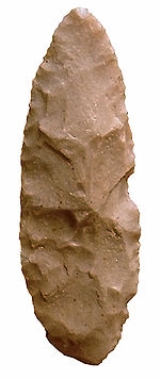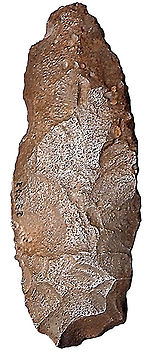
Late Stone Age
Encyclopedia
 |
 |
The Later Stone Age (LSA, sometimes also called the Late Stone Age) refers to a period in African prehistory
Prehistory
Prehistory is the span of time before recorded history. Prehistory can refer to the period of human existence before the availability of those written records with which recorded history begins. More broadly, it refers to all the time preceding human existence and the invention of writing...
. Its beginnings are roughly contemporaneous with the European Upper Paleolithic
Upper Paleolithic
The Upper Paleolithic is the third and last subdivision of the Paleolithic or Old Stone Age as it is understood in Europe, Africa and Asia. Very broadly it dates to between 40,000 and 10,000 years ago, roughly coinciding with the appearance of behavioral modernity and before the advent of...
. It lasts until historical times and thus includes cultures corresponding to Mesolithic
Mesolithic
The Mesolithic is an archaeological concept used to refer to certain groups of archaeological cultures defined as falling between the Paleolithic and the Neolithic....
and Neolithic
Neolithic
The Neolithic Age, Era, or Period, or New Stone Age, was a period in the development of human technology, beginning about 9500 BC in some parts of the Middle East, and later in other parts of the world. It is traditionally considered as the last part of the Stone Age...
in other regions.
Main characteristics
The LSA follows the Middle PaleolithicMiddle Paleolithic
The Middle Paleolithic is the second subdivision of the Paleolithic or Old Stone Age as it is understood in Europe, Africa and Asia. The term Middle Stone Age is used as an equivalent or a synonym for the Middle Paleolithic in African archeology. The Middle Paleolithic and the Middle Stone Age...
and begins about 50,000 years ago. The LSA is characterized by a wider variety in stone artifacts than the previous MSA period. These artifacts vary with time and location, unlike Middle Stone Age
Middle Stone Age
The Middle Stone Age was a period of African Prehistory between Early Stone Age and Late Stone Age. It is generally considered to have begun around 280,000 years ago and ended around 50-25,000 years ago. The beginnings of particular MSA stone tools have their origins as far back as 550-500,000...
technology which appeared to have been relatively unchanged for several hundreds of thousands of years. LSA technology is also characterized by the use of bone tools. The LSA was associated with Modern human behavior but this view was modified after discoveries in MSA sites such as Blombos Cave
Blombos Cave
Blombos Cave is a cave in a calcarenite limestone cliff on the Southern Cape coast in South Africa. It is an archaeological site made famous by the discovery of 75,000-year-old pieces of ochre engraved with abstract designs and beads made from Nassarius shells, and c. 80,000-year-old bone tools...
or Pinnacle Point.
See also
- Upper PaleolithicUpper PaleolithicThe Upper Paleolithic is the third and last subdivision of the Paleolithic or Old Stone Age as it is understood in Europe, Africa and Asia. Very broadly it dates to between 40,000 and 10,000 years ago, roughly coinciding with the appearance of behavioral modernity and before the advent of...
- Middle Stone AgeMiddle Stone AgeThe Middle Stone Age was a period of African Prehistory between Early Stone Age and Late Stone Age. It is generally considered to have begun around 280,000 years ago and ended around 50-25,000 years ago. The beginnings of particular MSA stone tools have their origins as far back as 550-500,000...
- Enkapune Ya MutoEnkapune Ya MutoEnkapune Ya Muto, also known as Twilight Cave, is a Late Stone Age site on the Mau Escarpment of Kenya. Beads made of perforated ostrich egg shells found at the site have been dated to 40,000 years ago. The beads found at the site represent some of the earliest known personal ornaments.-External...
- Mumba CaveMumba caveMumba Cave or Mumba Rockshelter is an archeological site located in Tanzania near Lake Eyasi, that was found to contain important Middle Stone Age and Late Stone Age artifacts. The cave was originally excavated by Ludwig Kohl-Larsen and his wife Margit in the 1930s.-External links:*...
- Mumbwa Cave

